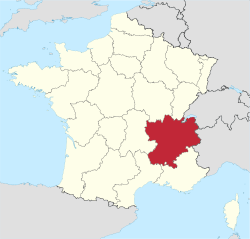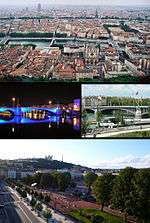Rhône-Alpes
| Rhône-Alpes | |||
|---|---|---|---|
| Region of France | |||
| |||
 | |||
| Country |
| ||
| Prefecture | Lyon | ||
| Departments |
8 + 1 Metropolis
| ||
| Government | |||
| • President | Jean-Jack Queyranne (PS) | ||
| Area | |||
| • Total | 43,698 km2 (16,872 sq mi) | ||
| Population (2014-01-01) | |||
| • Total | 6,449,000 | ||
| • Density | 150/km2 (380/sq mi) | ||
| Time zone | CET (UTC+1) | ||
| • Summer (DST) | CEST (UTC+2) | ||
| ISO 3166 code | FR-V | ||
| GDP (2013){{{GDP_ref}}} | Ranked 2nd | ||
| Total | €204.7 billion (US$269.4 bn) | ||
| Per capita | €31,231 (US$39,898) | ||
| NUTS Region | FR7 | ||
| Website |
www | ||
Rhône-Alpes (French pronunciation: [ʁon.alp]; Arpitan: Rôno-Arpes; Occitan: Ròse-Aups; Italian: Rodano-Alpi) is a former administrative region of France. Since 1 January 2016, it is part of the new region Auvergne-Rhône-Alpes.[1] It is located on the eastern border of the country, towards the south. The region was named after the Rhône and the Alps mountain range. Its capital, Lyon, is the second-largest metropolitan area in France after Paris. Rhône-Alpes has the sixth-largest economy of any European region.
Geography

Rhône-Alpes is located in the east of France. To the north are the French regions of Bourgogne (Burgundy) and Franche-Comté, to the west it borders the region Auvergne, to the south it borders Languedoc-Roussillon and Provence-Alpes-Côte d'Azur. The east of the region contains the westernmost part of the Alps and borders Switzerland and Italy. The highest peak is Mont Blanc, on the French-Italian border. The central part of the region comprises the river valleys of the Rhône and the Saône. The confluence of these two rivers is at Lyon. The western part of the region contains the start of the Massif Central mountain range. The region also borders or contains major lakes such as Lake Geneva (Lac Léman) and Lake Annecy. The Ardèche flows through the southwest portion of the region, where it has carved the deepest gorge in Europe.
As with the rest of France, French is the only official language of the region. Until the mid-20th century, Arpitan was widely spoken in the whole region, while many of the inhabitants of the south spoke varieties of Occitan; both are in steep decline in this region. There are immigrant populations from Armenia, Italy, North Africa, Poland and Portugal amongst other places.
Rhône-Alpes is made up of the following departments:
- Ain (01). Capital: Bourg-en-Bresse
- Ardèche (07). Capital: Privas
- Drôme (26). Capital: Valence
- Isère (38). Capital: Grenoble
- Loire (42). Capital: Saint-Étienne
- Rhône (69). Capital: Lyon
- Savoie (73). Capital: Chambéry
- Haute-Savoie (74). Capital: Annecy
And, since 2015, Metropolis with territorial collectivity statute:
- Metropolis of Lyon (69). Capital: Lyon
Population
Rhône-Alpes contains 3 major cities in France. It forms the triangle Lyon - Grenoble - Saint-Étienne. This triangle is the economic core of the region. These three urban areas are very complementary, and have smaller cities around, like satellites.
- Lyon area : 2,188,759 inhabitants (2011)
- Grenoble area : 675,122 inhabitants (2011)
- Saint-Étienne area : 508,548 inhabitants (2011)
- Valence area : 175,095 inhabitants (2011)



Prefectures
This list is from biggest agglomeration to the smallest:
- Lyon (Rhône)
- Grenoble (Isère)
- Saint-Étienne (Loire)
- Valence (Drôme)
- Chambéry (Savoie)
- Annecy (Haute-Savoie)
- Bourg-en-Bresse (Ain)
- Privas (Ardèche)
History
Although there have been people in Rhône-Alpes since pre-historic times, the earliest recorded settlers of the region were the Gauls (Celts). Cities such as Lyon were founded by them and the region traded with both northern and southern Europe. Most of the area became part of Roman territory during the invasion of Celtic Gaul led by Julius Caesar and was at various times part of the regions of Lugdunensis and Gallia. Lyon itself became a major city in the Roman Empire.
The region, excepting Savoy, was part of the Merovingian and Carolingian Kingdoms before becoming a royal territory under the Capetians. As it became a royal territory early on in French history, its cultural, political and economic influences and developments paralleled those of greater France. (See History of France.)
Transportation
Rhône-Alpes is a major European transit hub, linking northern France and Europe to the Mediterranean area. Millions travel along its motorways in summertime from Paris to holidays at the sea. The E15 Euroroute (Britain to Spain) runs through the region. There are international airports at Lyon, Grenoble and Saint-Étienne and many other minor airports and airfields. The region is also a transport hub for the rail-network with the TGV running through Lyon from Paris and the north, to the Mediterranean. A high-speed rail link is planned from Lyon to Turin.
Economy
Rhône-Alpes is a prosperous region which can be seen by its per capita GDP of about €31,231 ($40,000), which is higher than the French average, and an average income of €35,910 ($50,246), its economy second in size only to Île-de-France in France. This can be attributed to the diversity of the production in different sectors. The region is one of the Four Motors for Europe.
- Industry, in particular:
- Services, in particular:
- High-tech industries & nanotechnology, especially in Grenoble
- Optic and design in Saint-Etienne
- Tourism with the Alps (for skiing), Lyon and Grenoble (for culture) and the Ardèche (adventure sports/camping) particularly popular
- Education, with major universities in Lyon, Grenoble and Saint-Etienne.
In the past mining, especially coal mining was an important sector, particularly around Saint-Étienne, although this has declined since the 1970s.
The area of the region that lies close to Switzerland has an economy linked to that of Geneva. This area forms a hinterland for the Geneva hub.[2]
The Triangle of Lyon, Saint-Étienne and Grenoble contribute a GDP of €145 billion to the region. Add Valence to it, it is almost €150 billion. In addition, Lyon alone has a Gross Metropolitan Product of about €85 billion.
Also, Lyon's 3rd arrondissement hosts La Part-Dieu, which is the 2nd largest business district in France, just behind La Défense in Paris. La Part-Dieu alone provides more than 50,000 jobs in Lyon.
Major cities
Food
Lyon is noted as a gastronomic centre of France and specialities served in its traditional bouchons include Lyon sausage, sophisticated salami (known there as "rosette"), tripe and quenelles. In the east of the region the food has an Alpine flavour with dishes such as fondue, raclette common, gratin dauphinois and gratin savoyard. The region is also famous for its Bresse poultry and the many varieties of cheese including Tomme de Savoie, Bleu de Bresse, Reblochon, Saint-Marcellin and Vacherin.
Wines in this region include the very famous Beaujolais, Côtes du Rhône and Savoy wine. Chartreuse liqueur is made in the region.
Winter Olympics
Rhône-Alpes region has hosted the Winter Olympics three times; in 1924 at Chamonix, 1968 at Grenoble, and 1992 at Albertville. Annecy tried to be 4th city, but it failed, getting outvoted by Pyeong-Chang.
Tourism
Situated between Paris and the Côte d’Azur, on the border with both Switzerland and Italy, and offering access to two international airports (Lyon and Geneva), impressive rail connections and a vast motorway network, the Rhône-Alpes region is at "the crossroads of Europe".
Boasting eight natural parks and peerless sites such as Mont Blanc and the Gorges de l’Ardèche, Rhône-Alpes offers a wide range of different landscapes: mountains, vineyards and gentle valleys, fields of lavender and olive groves.
Every form of sport is readily available, set against an impressive natural backdrop: skiing, hiking, mountain biking or even paragliding and canoeing. Besides hosting three Winter Olympics games due to its being the largest ski area in the world, Rhône-Alpes is the second most important golfing region in France with over 60 courses.

Enthusiasts of art and culture will not be disappointed by the region’s Villes d’Art: Lyon, which is classified by UNESCO as a World Heritage site, Annecy, Grenoble, Chambéry, and Saint-Étienne.
And last but not least, connoisseurs of good food and wine will be spoilt for choice by the range of local specialties available to taste along with a Beaujolais or a Côtes du Rhône, and by the sheer number of famous restaurants (with Paul Bocuse at the top of the list) in the region.
Lakes
There are six main lakes in Rhône-Alpes
Gastronomy
For several centuries Lyon, capital of Rhône-Alpes, has been known as the French capital of gastronomy, due, in part, to the presence of many of France's finest chefs in the city and its surroundings (e.g. Paul Bocuse). This reputation also comes from the fact that two of France's best known wine-growing regions are located near Lyon: the Beaujolais to the North, and the Côtes du Rhône to the South. Beaujolais wine is very popular in Lyon and remains the most common table wine served with local dishes.
Lyon is the home of very typical and traditional restaurants: the bouchons. Bouchons are usually convivial restaurants serving local dishes, and local wines.
Lyon is famous for its morning snacks, the mâchons, made up of local charcuterie, especially the rosette and usually accompanied by Beaujolais red wine. Traditional local dishes include saucisson de Lyon (sausage), andouillette, coq au vin, esox (pike) quenelle, gras double (tripe cooked with onions), salade lyonnaise (lettuce with bacon, croutons and a poached egg), marrons glacés and cardoon au gratin.
See also
| Wikimedia Commons has media related to Rhône-Alpes. |
References
- ↑ Loi n° 2015-29 du 16 janvier 2015 relative à la délimitation des régions, aux élections régionales et départementales et modifiant le calendrier électoral (in French)
- ↑ "Rhone Alpes Economy". French-property.com. Retrieved 2013-09-06.
External links
- Rhône-Alpes page on france.fr- official French website (in English)
- Rhône-Alpes Tourisme- travel website
| ||||||||||||||||||||||||
|



